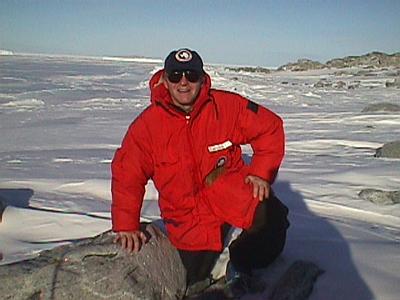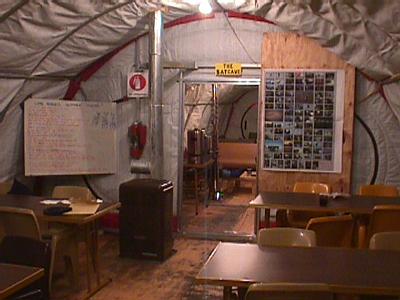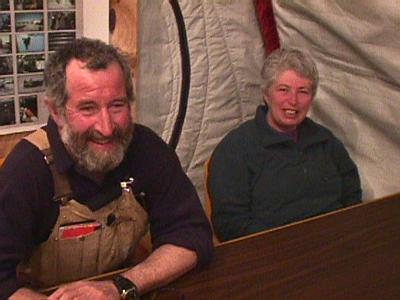15 November, 1999
My Cape Roberts adventure continues. The CPR Base Camp is located off the
Scott Coast of the Antarctic Continent on about 2 meters of annual ice. It
is where the drillers, scientists and support personnel live from October
until early December when the drilling portion of the CRP ends due to the
sea ice melting. The camp has about 35 residents although this varies as
people, like me, go in and out on a daily basis. Most of the people here
stay out on the ice for the entire drilling season. As you approach the camp
from the air, you see a cluster of attached, rectangular boxes and two
connected tent-type structures. We were met by Kath Varcoe, who gave us an
orientation to life at Cape Roberts camp. We were assigned sleeping quarters
in a metal container about 6 feet by 12 feet in size which had berths for 6
people in it. It reminded me a lot like a walk-in cooler, only in reverse.
You were keeping the cold out. You might have a problem sleeping in one of
these if you were claustrophobic. The camp has a diesel generator for
electrical power, a reverse osmosis desalination unit for water, a dining
room, galley and lounge area. Outside there were tractors, snowmobiles,
storage buildings, a small sun porch, volleyball net and a toilet. The
toilet is simply a hole cut in the ice with a small "outhouse" built over
it. The building is moved from time to time and the hole is filled with ice.
Overall, the camp is very functional and comfortable. The people staying
there seemed happy they were here.
The area around the camp is absolutely beautiful. It is the vision
most people have of Antarctica. The Transantarctic Mountains rise in
distance. Piedmont glaciers come to the shore north and south of the camp.
The glaciers calve off large icebergs that are frozen in the sea ice all
around the camp. These are bergs that didn't drift to open water before they
were trapped in the ice. When the sea ice melts, they will drift in to the
Ross Sea. There are several flagged routes around the camp which allow you
to get closer to the bergs. But first, I wanted to walk to Cape Roberts.
This is a part of the continent of Antarctica jutting out into the sea. When
I walked on this point of land, I could now say I really was on the
continent for the first time. Cape Roberts is also a nesting area for skuas,
the Antarctic seagull-like bird, and I saw several.
Massimo, Wojciech and I went for a walk among the bergs. They are
quite impressive. I will tell you a lot more about these pieces of glaciers
later this week. Wojciech and I then went for a walk out towards a large
crack in the sea ice. Lined up along this crack we saw 7 large Weddell
seals. Each one of the females had a seal pup with them. We were very
careful not to get too close to the seals, as they can get upset and in
moving they may hurt the pups. I didn't get any good pictures with my
digital camera, but I was surprised by how big the gray pups were. They all
stayed very close to their mothers.
After our walk, we went back to the camp and sat in the lounge with
some of the other people staying there. The drillers and scientists were
having a bit of a break at the time because the drilling had stopped for a
couple of days to do some testing on the rocks in the drill hole. I met Dr.
Tim Paulsen, a geology professor from the University of Wisconsin - Oshkosh.
He was celebrating his 32nd birthday and there was a small party for him.
About midnight, with the sun shinning bright in the sky, I decided it was
time to go to sleep. I went off to my "container" and climbed into my upper
bunk. The bunk was just barely long enough for me and the ceiling was about
20 inches above my face. I pulled the curtain on the cubicle shut and I had
a very nice nights sleep.
The next morning, I got up early and took a walk to a snowy hill
above the camp at the nose of a glacier. When I got to the top, I looked
around at the magnificent site of mountains, icebergs, glaciers, and frozen
sea and was struck by how fortunate I was to be in the fantastic place. Wow!
This surely is a wonderful planet. It is too bad all places on it are not as
unspoiled as this place. Let's hope Antarctica stays this way.
After a very good breakfast, we headed out to the helo pad to catch the
shift chance flight to the drill site. Tomorrow I will show you the drilling
rig and you can meet Frank the seal.
In my continuing effort to recognize some of the people who are
making the Cape Roberts Project a success, I want you to meet two of the
people who help run the CRP base camp. They are Brian Reid, an electrician
and all around fix it guy and Kath Varcoe, the Camp Assistant. Kath does
whatever needs to get done to keep the camp running smoothly, including
meeting and keeping track of visitors, like me. Thanks Kath. Both Brian and
Kath are from Christchurch, New Zealand.

The Camp Roberts Base Camp. The red and white structures with the curved roofs are the dining hall and the lounge area.

Here I am actually touching the Antarctic Continent for the first time.

The dining hall and the lounge area, dubbed the "Bat Cave".

The galley at CRP base camp. The food is very good at the camp.

The view above CRP base camp with icebergs frozen in the sea and Mt. Erebus on the horizon. I was very happy to be in this beautiful place.

Brian Reid and Kath Varcoe help make the CRP base camp a very comfortable place to stay and work.
Contact the TEA in the field at
.
If you cannot connect through your browser, copy the
TEA's e-mail address in the "To:" line of
your favorite e-mail package.
|
